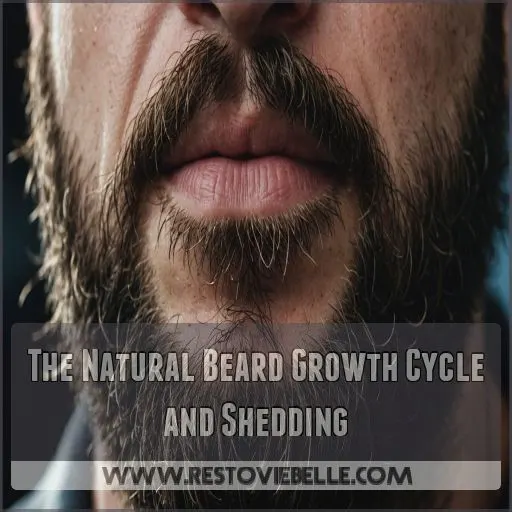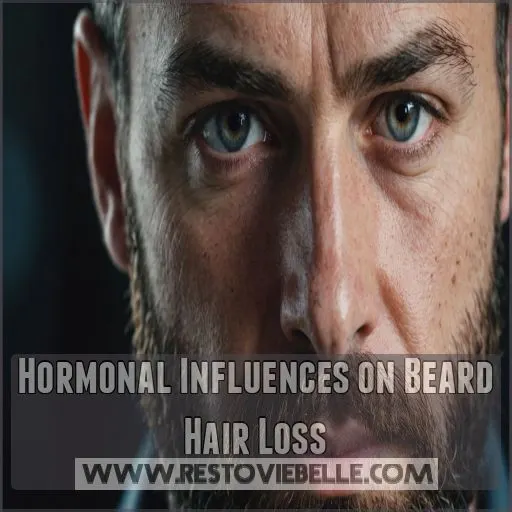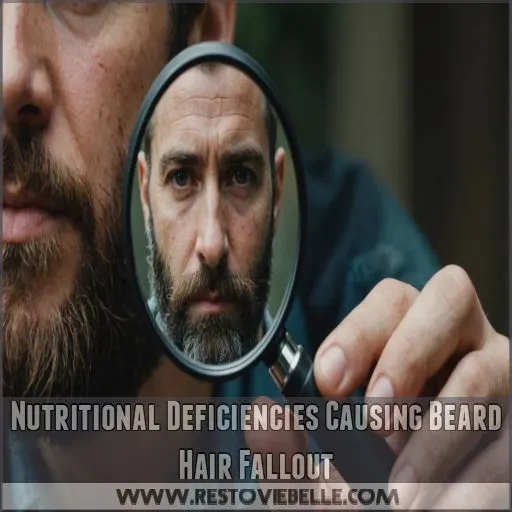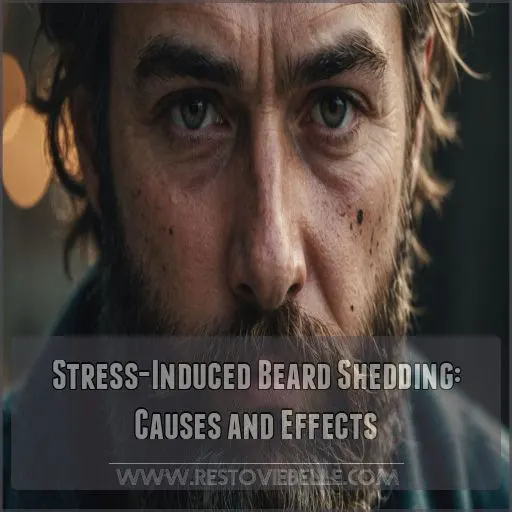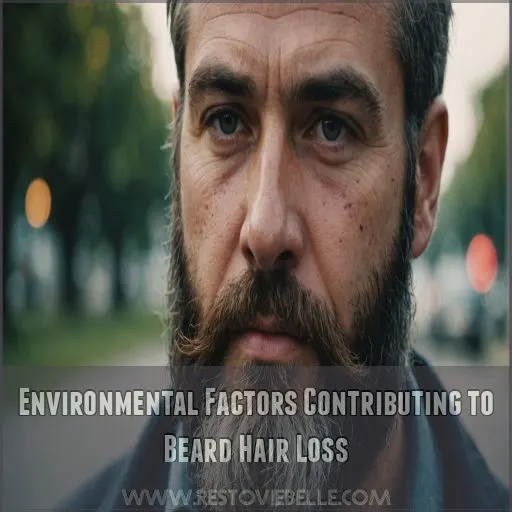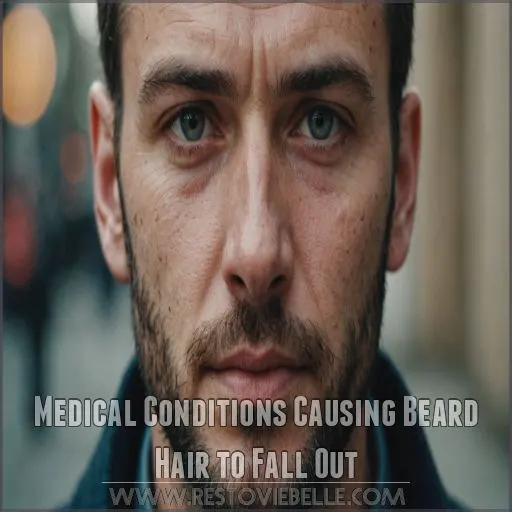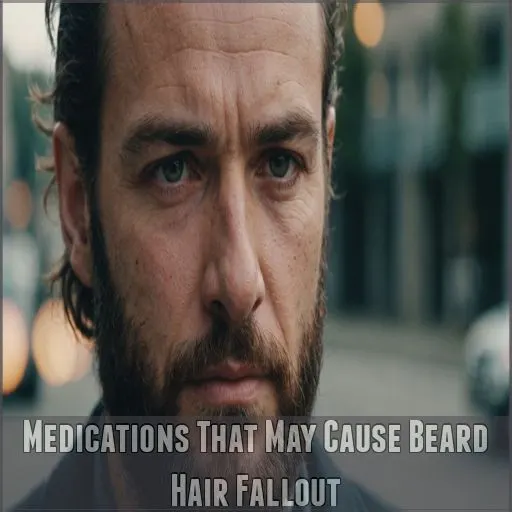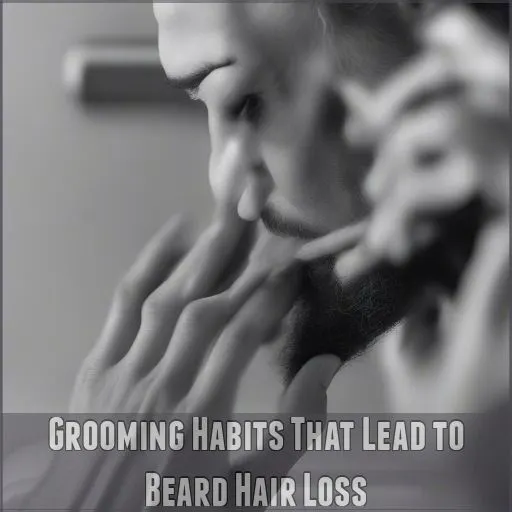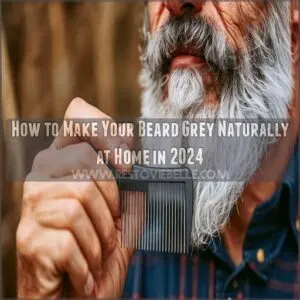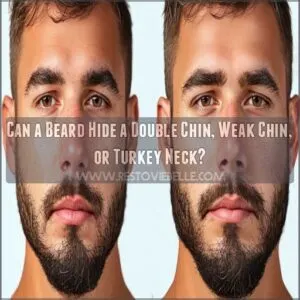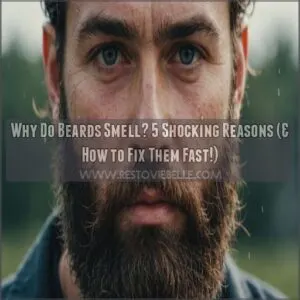This site is supported by our readers. We may earn a commission, at no cost to you, if you purchase through links.
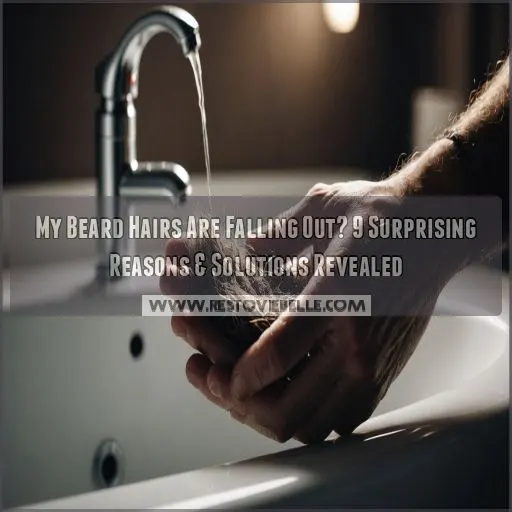
Like all hair, your beard naturally sheds between 50-100 hairs a day. But, if you’re seeing hair loss that gives you the heebie-jeebies, it could be more than just a part of the natural cycle.
Stress, hormonal imbalances, and poor nutrition can all give your facial forest a thinning look. Your beard is like a reflection of your overall health.
Want to step up your beard game? Stay tuned for some surprisingly easy fixes and smart grooming tips ahead!
Table Of Contents
- Key Takeaways
- The Natural Beard Growth Cycle and Shedding
- Hormonal Influences on Beard Hair Loss
- Nutritional Deficiencies Causing Beard Hair Fallout
- Stress-Induced Beard Shedding: Causes and Effects
- Environmental Factors Contributing to Beard Hair Loss
- Medical Conditions Causing Beard Hair to Fall Out
- Medications That May Cause Beard Hair Fallout
- Grooming Habits That Lead to Beard Hair Loss
- Treatment Options for Beard Hair Loss
- Frequently Asked Questions (FAQs)
- Can hair loss cause a beard to fall out?
- Why is my hair falling out?
- What causes a beard to fall?
- Should you freak out about beard hair loss?
- Where does hair loss occur on a beard?
- Is it normal for a beard to fall out every day?
- Why are my beard hairs falling out?
- How do I fix my lost beard hair?
- Can you lose beard hair from stress?
- Do you lose beard hair as you age?
- Can beard hair loss affect self-esteem?
- Does religious belief affect beard grooming?
- What are common types of alopecia affecting beards?
- Is beard dyeing linked to hair loss?
- Can psychological factors influence beard shedding?
- Conclusion
Key Takeaways
- Don’t panic if you see extra beard hairs in the sink—it’s normal to shed 50-100 hairs daily. Your beard is just going through the natural hair growth cycle, similar to leaves falling in autumn.
- Stress, hormonal imbalances, and nutrition play a big role in beard health. Just as a plant needs water, your beard thrives on a balanced diet and a peaceful state of mind. So, eat well and relax.
- Environmental factors and grooming habits can also cause your beard to misbehave. Over-brushing, heat styling, or even sun and pollution exposure can weaken those whiskers—treat them with care, as you would precious cargo.
- If you’re experiencing more than the usual shedding, consider consulting a dermatologist. Conditions like alopecia or thyroid issues might be behind your disappearing beard, but treatments are available to help revive its glory.
The Natural Beard Growth Cycle and Shedding
If you’ve noticed beard hairs in your sink, don’t panic just yet.
Understanding the natural beard growth cycle can help you distinguish between normal shedding and excessive hair loss, giving you peace of mind about your facial fuzz.
Anagen, Catagen, and Telogen Phases
Your beard’s going through a wild ride! It’s constantly cycling through three phases: anagen (growth), catagen (transition), and telogen (rest) .
During anagen, your facial hair’s in full-on growth mode, while catagen signals a slowdown .
Telogen’s the chill phase where your beard takes a breather . Understanding these stages can help you crack the code of your beard’s behavior and keep it looking its best.
Normal Daily Hair Loss in Beards
Just like the hair on your head, your beard isn’t immune to shedding.
It’s perfectly normal to lose 50-100 beard hairs daily . Don’t panic when you spot a few strays in your sink or on your pillow.
This natural process is part of the hair growth cycle, where old hairs make way for new ones.
Remember, a little shedding doesn’t mean you’re on the fast track to a patchy beard. This is just a normal part of beard maintenance, and it’s not a cause for concern. However, it is a natural process that can be influenced by a little shedding.
Follicle Regeneration and New Growth
Learn about the fascinating world of beard follicle regeneration! Your facial hair is constantly renewing itself through a cycle of growth, rest, and shedding .
As old hairs fall out, new ones emerge from the same follicles, ensuring your beard’s ongoing vitality.
This process, known as the anagen phase, can last anywhere from two to six years for each hair .
It’s nature’s way of keeping your beard looking fresh and full.
Percentage of Resting Hairs in a Full Beard
In the midst of your beard’s growth cycle, you might be surprised to learn that about 10 to 15% of your facial hair is taking a well-deserved break at any given time .
This resting phase, known as telogen, can last anywhere from a few weeks to nearly a year, depending on the specific location of the hair.
It’s all part of your beard’s natural rhythm!
Distinguishing Normal Shedding From Excessive Loss
Now that you know about resting hairs, let’s tackle a common concern: how to tell if your beard shedding is normal or not.
You’re not alone if you’ve wondered, "Am I losing too much?" While it’s natural to shed 20-30 hairs daily , excessive loss might signal an underlying issue.
Keep an eye on your hairbrush and sink – if you’re seeing more than usual, it’s time to play detective and find the cause of the underlying issue.
Hormonal Influences on Beard Hair Loss
You’ve learned about the natural beard growth cycle, but hormones play a huge role in your facial hair’s health too. Ever notice how some guys seem to grow beards overnight while others struggle for years? It’s all about those hormones, especially testosterone and its more potent form, dihydrotestosterone (DHT) .
Think of hormones as your beard’s personal cheerleaders – when they’re in balance, your facial hair thrives. But if something throws them off, like age or certain medical conditions, your beard might start to thin out .
Conditions like polycystic ovary syndrome (PCOS) can actually cause excess hair growth in women, but in men, hormonal imbalances can lead to patchy or thinning beards . Even thyroid issues can impact your facial fuzz .
Don’t panic if you’re shedding more than usual – there are ways to tackle hormone-related beard loss. Let’s explore some solutions to help with hormonal imbalances.
Nutritional Deficiencies Causing Beard Hair Fallout
If you’re noticing more beard hairs in your sink lately, your diet might be to blame.
Nutritional deficiencies can wreak havoc on your facial fuzz, but don’t worry – we’ll explore the key nutrients your beard craves and how to keep it well-fed and thriving.
Essential Vitamins and Minerals for Beard Growth
Your beard’s health isn’t just skin deep – it’s rooted in what you eat! Just like a garden, your facial hair needs the right nutrients to thrive.
- Zinc: The follicle fortifier
- Vitamin C: The collagen catalyst
- Vitamin D: The hair loss hero
Remember, a balanced diet is your beard’s best friend. Skip the pricey "beard vitamins" and focus on nutrient-rich foods instead .
Impact of B-Vitamins on Keratin and Collagen Production
Three key B-vitamins play a big role in your beard’s health.
Biotin (B7) is the star player, promoting keratin production – the protein that forms your facial hair . While biotin deficiency is rare, it can lead to hair loss (Source).
B5 (pantothenic acid) and B3 (niacin) also support collagen synthesis, giving your beard strength and shine. Think of these vitamins as the building blocks for your manly mane!
Importance of a Balanced Diet for Beard Health
A balanced diet is the secret sauce for a healthy beard. Nourishing your facial follicles with the right nutrients can make all the difference.
Lean proteins, whole grains, and foods rich in zinc are your beard’s best friends . Don’t forget to load up on leafy greens and Brazil nuts for that extra boost of vitamins and minerals .
Your beard will thank you with lustrous, strong growth and this happens because of a combination of nutrients including foods rich in zinc.
Effects of Calorie Restriction on Testosterone Levels
While watching your waistline might seem like a good idea, extreme calorie restriction can throw a wrench in your beard-growing plans.
Studies show that drastically cutting calories can lead to a significant drop in testosterone levels, especially in lean men .
This hormonal dip may cause your facial hair to thin out or fall more rapidly. Striking a balance between healthy eating and maintaining adequate calorie intake is key for keeping your beard lush and full, as it helps maintain adequate calorie intake.
Role of Iron and Vitamin D in Hair Growth
Ever wondered why your beard’s looking a bit sparse? Iron and vitamin D play important roles in your facial hair’s growth cycle. These nutrients are like fertilizer for your follicles, helping them produce strong, healthy hairs.
- Iron deficiency can lead to hair loss, including in your beard
- Vitamin D supports hair follicle growth and health
- Fatty fish like salmon and mackerel are excellent sources of vitamin D
- Supplements may help, but consult your doctor first to avoid toxicity risks
Stress-Induced Beard Shedding: Causes and Effects
If you’re noticing more beard hairs in your sink lately, stress might be the culprit.
Let’s explore how the stress hormone cortisol can wreak havoc on your facial hair growth and what you can do about it.
Cortisol’s Impact on Hair Growth Cycle
You’ve nourished your beard, but it’s still shedding? Let’s talk about stress, the silent saboteur of your facial fuzz.
When you’re stressed, your body cranks up cortisol production, throwing your hair growth cycle into chaos . This stress hormone can wreak havoc on your beard’s natural rhythm:
| Cortisol Effect | Hair Growth Impact | Solution |
|---|---|---|
| Accelerates degradation | Shorter growth phase | Stress management |
| Reduces skin elements | Weaker hair follicles | Mindfulness practices |
| Disrupts normal cycle | Increased shedding | Regular exercise |
Don’t worry, though – understanding this connection is half the battle!
Androgen Suppression Due to Chronic Stress
Chronic stress doesn’t just mess with your mind—it’s also a sneaky beard thief!
When you’re constantly under pressure, your body pumps out stress hormones that can put the brakes on testosterone production. This androgen suppression is bad news for your facial fuzz.
Your beard relies on those manly hormones to stay thick and healthy.
So, if you’re noticing more hairs in the sink, it might be time to take a deep breath and tackle that stress head-on.
Cortisol’s Effect on Androgen Receptor Downregulation
Stress can wreak havoc on your beard, and cortisol is the culprit. This stress hormone downregulates androgen receptors, hampering your facial hair’s growth .
When cortisol levels spike, it’s like putting the brakes on your beard’s natural development.
Your follicles become less responsive to growth-promoting hormones like testosterone and DHT. The result? Your once-lush beard might start thinning out, leaving you scratching your chin in confusion, and wondering about the impact on your facial hair’s growth.
Environmental Factors Contributing to Beard Hair Loss
Your beard might be falling victim to more than just your grooming habits.
Environmental factors like sun exposure, dry climates, humidity, and pollution can all play a role in weakening your facial hair.
But don’t worry – we’ve got some tricks up our sleeve to help you protect your prized beard from these sneaky hair thieves, also known as environmental factors.
Sun Exposure and UV Damage to Facial Hair
The sun’s rays can be a hidden enemy to your luscious beard. While you’re soaking up the vitamin D, those UV rays are wreaking havoc on your facial hair.
Just like your skin, your beard needs protection from sunburns and damage (Source). Prolonged sun exposure can strip your beard of its natural color, leaving it lighter and more brittle.
Don’t let your beard become a sun-bleached mess! It can also strip your beard of its natural color. A hidden enemy to your luscious beard.
Effects of Cold and Dry Climates on Beard Health
Many bearded gents find winter’s icy grip wreaking havoc on their facial fuzz.
Cold, dry air can turn your once-lush beard into a brittle mess, leading to increased shedding . Your beard’s natural oils take a hit, leaving you with dreaded "bearddruff" .
Don’t fret! With a solid Winter Beard Grooming routine, you can keep your whiskers warm and healthy. Remember, lukewarm showers are your beard’s best friend in chilly weather.
Impact of Humidity on Beard Hair Structure
While cold climates can dry out your beard, humidity’s no picnic either.
Your facial hair acts like a sponge, soaking up moisture from the air . This swelling can lead to frizz and even breakage if you’re not careful .
Picture your beard as a delicate ecosystem – too much moisture throws it off balance.
But don’t worry, we’ve got some tricks up our sleeve to keep your beard looking sharp in any weather.
Pollution’s Role in Weakening Beard Hairs
Your urban jungle might be wreaking havoc on your facial fuzz. Air pollution‘s microscopic menaces can weaken your beard hairs, leading to unexpected shedding.
These tiny troublemakers, like PM10 particles and diesel dust, lower proteins important for hair growth . They’re sneaky saboteurs, reducing levels of beta-catenin, cyclin D1, and CDK2 – the building blocks of your magnificent mane.
City life’s convenience comes at a cost, but don’t worry – your beard isn’t doomed! It’s all about finding a balance between city life and taking care of your beard.
Protective Measures for Environmental Stressors
You’ve learned about pollution’s impact on your beard, but don’t worry – there are ways to shield your facial fuzz from environmental stressors.
Sun protection is key: wear a hat or apply beard-friendly sunscreen.
When facing air pollution, rinse your beard daily and use a protective beard oil.
In cold weather, moisturize to prevent dryness.
For humid climates, a light leave-in conditioner can help control frizz and keep your beard looking sharp.
Medical Conditions Causing Beard Hair to Fall Out
If you’re noticing more beard hairs in your sink than usual, it mightn’t just be normal shedding.
Various medical conditions can cause your facial hair to fall out, from autoimmune disorders to skin issues.
Understanding these potential culprits is the first step in finding a solution.
Alopecia Barbae: Symptoms and Causes
Ever noticed patchy spots in your beard? It might be alopecia barbae, an autoimmune condition causing hair loss in small, circular areas . This sneaky culprit can strike anyone, but don’t panic!
- Symptoms: Sudden hair loss in quarter-sized patches
- Location: Typically along the jawline
- Progression: Can spread or remain isolated
- Risk factors: Family history of autoimmune disorders
Remember, you’re not alone in this hairy situation. Let’s explore treatment options to help you regain your magnificent mane!
Thyroid Disorders and Their Effect on Beard Growth
The butterfly-shaped gland in your neck might be the culprit behind your disappearing beard. Thyroid disorders can wreak havoc on hair growth, including facial hair.
Let’s take a closer look at how these tiny hormones can impact your manly mane:
| Condition | Effect on Beard | Treatment Impact |
|---|---|---|
| Hypothyroidism | Thinning, brittle hair | Regrowth possible |
| Hypothyroidism | Thinning, brittle hair | Regrowth possible |
| Hashimoto’s | Gradual thinning | Variable results |
| Graves’ Disease | Rapid shedding | Improvement likely |
| Thyroid Nodules | Minimal impact | Minimal change |
Tackling thyroid issues often leads to beard recovery, so don’t lose hope!
Autoimmune Diseases Impacting Facial Hair
Just as thyroid issues can affect your beard, other autoimmune diseases can wreak havoc on your facial hair.
Alopecia areata, for instance, is like a mischievous imp that convinces your immune system to attack hair follicles, causing patchy hair loss .
It’s not just limited to your scalp – your beard can fall victim too.
Don’t panic though; there are treatments available, from corticosteroids to minoxidil, that can help tame this follicular rebellion .
Seborrheic Dermatitis and Beard Hair Loss
Moving on from autoimmune issues, let’s tackle another pesky problem that might be causing your beard to thin out: seborrheic dermatitis. This common skin condition can leave those annoying flakes in your facial hair .
Don’t worry, though – it’s not a hygiene issue! Seborrheic dermatitis can cause itching and inflammation in your beard area, potentially leading to temporary hair loss .
But fear not, bearded friend – with proper treatment, your whiskers will be back in action in no time!
Other Medical Conditions Affecting Beard Health
Beyond seborrheic dermatitis, your beard might be shedding due to other medical curveballs.
Thyroid disorders can throw your hair growth into a tailspin, while autoimmune diseases might cause your body to attack its own follicles .
alopecia areata could be the culprit behind those pesky bald patches, and even stress-induced hair pulling disorders can leave your beard looking patchy.
Don’t worry though – most of these conditions are treatable with proper diagnosis and care.
Medications That May Cause Beard Hair Fallout
If you’re noticing more beard hairs in the sink lately, your medicine cabinet might hold some clues.
Certain medications, from chemotherapy drugs to common blood pressure pills, can have the unexpected side effect of thinning out your facial fuzz.
Chemotherapy Drugs and Hair Loss
Chemotherapy’s impact on your beard can be a tough pill to swallow.
You’re not alone if you’ve noticed your facial hair thinning or falling out during treatment.
Chemo targets rapidly growing cells, including those in your hair follicles .
The good news is that hair loss is typically temporary, with regrowth starting 3-6 months after treatment ends (Source).
In the meantime, explore wig options or embrace the smooth look – you’ve got this!
Anti-Parkinsonian Medications’ Side Effects on Hair
When tackling Parkinson’s, medication effects might unexpectedly include hair thinning.
It’s like your beard takes an uninvited holiday! Not all anti-Parkinsonian medications cause hair loss, but if your facial fuzz starts vanishing, consult your healthcare provider.
Together, you’ll find a balance between managing Parkinson’s symptoms and keeping your beard goals on track.
Remember, you’ve got options!
HIV Medications and Their Impact on Beard Growth
Did you know HIV medications might make your beard go AWOL? It’s not just about viral suppression; sometimes, they tag along uninvited side effects.
Many of these side effects include beard thinning. While hair loss sounds like an unexpected plot twist, know that various treatment options exist to tackle this issue head-on.
Many men keep their beards looking sharp with these treatment options , dealing effectively with the problem of hair loss.
Anticoagulants and Antidepressants Affecting Hair Follicles
Ever feel like your beard’s staging a disappearing act?
Medications like anticoagulants and antidepressants can be the sneaky culprits behind hair loss, affecting beard follicles .
Think of it as an unexpected plot twist in your beard journey.
But fear not: with some know-how on medication interactions and lifestyle tweaks, you can reclaim control and keep those whiskers robust.
Antihypertensive Drugs’ Role in Beard Shedding
Certain antihypertensive medications like minoxidil can cause unwanted beard hair loss. This common side effect is linked to the drug’s impact on potassium channels and hair follicles.
Speak with your doctor about alternative treatment options that won’t compromise your facial hair. With the right approach, you can maintain a healthy, full beard.
Grooming Habits That Lead to Beard Hair Loss
If your beard’s shedding more than you’d like, your grooming habits might be the sneaky culprits.
From overzealous brushing to heat styling, how you care for your beard can make a big difference in keeping it full and healthy.
Excessive Brushing and Its Impact on Hair Breakage
Excessive brushing is like overwatering a plant; it seems helpful but can cause harm.
Using the right beard brush types, combined with a gentle brush stroke technique, prevents hair breakage.
Spread beard oil to fortify strands, easing tangles and nourishing hair.
Embrace gentle grooming habits to maintain control and help your beard thrive without unintended fallout .
Tight Styling and Its Effect on Hair Follicles
When you pull your beard tightly into a style, it’s like walking a tightrope; too much tension, and the follicles might let go. This strain can cause breakage and hair loss.
- Avoid styles that pull too tightly.
- Let your beard breathe with looser styles.
- Change up your look often to give follicles a break .
Heat Styling Tools and Their Damage to Facial Hair
Heat styling tools can really scorch your beard hair, leading to breakage and dullness.
Imagine a sponge drying out—that’s your beard overcooked!
Keep that beard healthy by lowering the heat and using protective products. Your face will thank you and so will your beard .
Treat that facial fuzz with respect, and it’ll look its best!
Importance of Gentle Beard Care Techniques
Hot styling can hurt your beard, so embrace gentle grooming! Choose the right comb and brush, distribute oils evenly, and wash with specialized beard shampoos .
Trim regularly to maintain shape without risking hair loss. Your beard’s journey is like shaping a bonsai tree—patience and care are key.
Keep it hydrated, tidy, and healthy for the best results.
Treatment Options for Beard Hair Loss
When your beard starts shedding more than you’d like, it’s time to explore treatment options that can help.
Whether you’re dealing with inflammation or looking to boost hair growth, using corticosteroids, minoxidil, or even trying anthralin cream could be your beard’s saving grace.
Corticosteroids for Reducing Inflammation
If your beard hair is thinning due to inflammation, corticosteroids could be the solution. These powerful anti-inflammatory creams like clobetasol propionate and betamethasone valerate can reduce follicle irritation and stimulate regrowth.
Just be careful – overuse can cause side effects like skin thinning. Follow your doctor’s guidance on proper dosage and application.
- Reduces inflammation in hair follicles
- Promotes regrowth of beard hair
- Available as prescription-strength creams
- Use as directed to avoid side effects
- Consult your dermatologist for best results
Minoxidil as a Topical Treatment for Hair Growth
Thinking about using minoxidil for your beard? It’s a popular choice for those itching to boost their facial hair growth.
Apply it twice daily, but be ready for potential side effects like dry skin and redness.
While results can vary, many find it effective. Still, don’t let it become the holy grail—explore alternatives too!
Anthralin Cream for Facial Hair Thinning
Ever thought about trying anthralin cream for beard hair loss?
It’s one option for tackling alopecia barbae, and can encourage hair growth by diverting your immune system’s attention away from those stubborn follicles .
Keep in mind anthralin might cause some irritation, but with perseverance, it could help your beard wave goodbye to those bare patches.
Baricitinib and Other FDA-Approved Treatments
Feeling like your beard’s pulling a disappearing act?
Let’s tackle it with Baricitinib, one of the FDA-approved treatments for hair loss.
This option, known for tackling Alopecia Areata, can spark hair regrowth and offers hope.
Just remember, there might be side effects, so chatting with a doctor first can keep you on the safe side .
Frequently Asked Questions (FAQs)
Can hair loss cause a beard to fall out?
Absolutely, hair loss can cause your beard to fall out due to alopecia barbae, stress, or nutritional deficiencies.
But don’t fret! Treatments like corticosteroids or minoxidil can help stimulate regrowth and restore your beard’s glory .
Why is my hair falling out?
Your hair may be falling out due to factors like stress, hormonal changes, or a medical condition. Don’t worry – there are treatments that can help restore your luscious locks.
What causes a beard to fall?
Beard hair loss can stem from various causes such as alopecia, stress, nutritional deficiencies, or even excessive grooming.
Consider autoimmune disorders like alopecia barbae, fungal infections, or hormonal imbalances as possible culprits affecting your beard’s wow factor .
Should you freak out about beard hair loss?
Don’t panic about losing some beard hair.
It’s often temporary and can link to stress, diet, or minor health issues.
Chat with a dermatologist if needed, but usually, it’s just part of the beard’s natural process .
Where does hair loss occur on a beard?
Like leaves in autumn, facial hairs can fall from your beard in uneven patches, often appearing on the cheeks and chin.
Sometimes, beard hair loss is linked to genetic patterns or autoimmune conditions .
Is it normal for a beard to fall out every day?
Yes, it’s normal for some beard hairs to shed daily due to the natural hair growth cycle.
Like leaves in autumn, they fall to make room for new growth, so no need to stress .
Why are my beard hairs falling out?
Around 2% of people experience alopecia areata, which can cause beard hair loss .
Relax, you’re not alone! Stress, genetics, or even an autoimmune condition might be the culprits.
Consider consulting a doctor for personalized advice.
How do I fix my lost beard hair?
Don’t worry, there are plenty of effective treatments to regrow your lost beard hair.
Try topical corticosteroids, laser therapy, or JAK inhibitors.
Many men see full beard regrowth within 6 months.
Can you lose beard hair from stress?
Your beard can be like a weathervane of stress, revealing life’s turmoil.
Stress-induced conditions like telogen effluvium and alopecia areata can cause your beard to thin and shed.
Fortunately, it’s often reversible with care .
Do you lose beard hair as you age?
Absolutely, you can lose beard hair as you age.
It’s common for hair thickness and growth to change over time; your once robust beard might start shedding a bit more, just like leaves in autumn .
Can beard hair loss affect self-esteem?
Losing beard hair can sting, turning your daily mirror check into an existential drama.
But remember, you’re not alone in this hairy predicament.
Though self-esteem might quiver, confidence’s foundation is much sturdier than any rogue whisker.
Does religious belief affect beard grooming?
Religious beliefs can indeed influence how you manage your beard.
Many faiths, like Sikhism or Islam, include guidelines on beard grooming as spiritual practice.
Often requiring adjustments for workplace dress codes .
What are common types of alopecia affecting beards?
Everyone wants a full beard, but alopecia barbae can act like an unwelcome barber.
This condition, an autoimmune disorder, creates patchy bald spots on your beard, affecting the jawline and cheeks.
Treatment options exist, like corticosteroids and Minoxidil .
Is beard dyeing linked to hair loss?
While beard dyeing can potentially irritate the skin and damage hair follicles, leading to temporary hair loss.
The research doesn’t show a direct, long-term connection between beard dye and permanent beard hair loss.
Can psychological factors influence beard shedding?
Stress can indeed cause your beard to shed like leaves in autumn.
Psychological stress may lead to alopecia, affecting hair, including beard .
Managing stress could help keep your beard intact and glorious.
Conclusion
Facing beard hair loss can feel like one’s facial forest is thinning, but don’t panic—nature’s got its quirks. Your beard shedding isn’t always a tragedy.
With simple lifestyle tweaks and proper care, you can regain your beard’s glory. Pay attention to dietary needs, manage stress, and be mindful of grooming habits.
And when the going gets tough, consider treatments like minoxidil. Remember, your beard’s health mirrors your own, so nourish it well!

